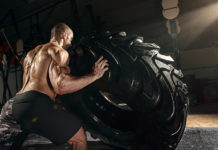
RedCon1 – How to Implement RPE Into Your Training
I wanted to deviate from my typical articles covering supplements and bring a little focus into training. In this article I wanted to discuss a simple yet extremely effective way to undulate progression using a highly auto-regulated approach that incorporates a high amount of biofeedback. This method is called rated perception of exertion or RPE. Lets face it, we all love being in the gym and for myself, the longer and more frequently I can be there, the better. The issue is, we cannot always have high training volume, high training frequency, and high training intensity. If all three variables of training are kept at a constant high, you will most likely hit a wall, risk injury, and need to take further time out from the gym due to actual overtraining or central nervous system hyperstimulation.
This is where RPE comes into play as it is a way to undulate intensity factors to avoid any overtraining type scenarios (not to be confused with planned overreaching which we will get to in another article.) The RPE system comes from reactive training that is used to measure the intensity of your specific set or exercise on that day. Yes that is right, it is measuring your strength for that given workout at that specific point in time. This is where the auto-regulated biofeedback comes into play. Lets say one say you go into the gym completely fresh with a good nights sleep and a solid previous day’s worth of nutrition. Your performance that day will most likely be improved and at its peak compared to a different day of the week where your nutrition was slightly off the day before and you didn’t get enough sleep the previous night. Whichever day you chose (either the well rest high performing day or the poor rested poor performing day) your RPE number will stay the same but the poundage used on that specific exercise will change. There are many RPE scales out there but we will focus on a very basic 1-10 scale.
BASIC RPE SCALE (1-10)
RPE10 – this is your maximal weight and there is no possible way you can complete another full rep without failing
RPE9 – this means your last rep is a struggle but you still have one rep left that you could complete
RPE9 – this means the weigh is still heavy but you have a good two to three solid reps left in you
RPE7 – this means your weight moves extremely fast and is challenging but no where near failure and is seen as heavy speed work
RPE6 – this means your using a weight you can move very fast with only moderate force and is seen as light speed work
RPE5 – this means your working with warm up poundages or possibly even higher repetition ranges such as fifteen to twenty plus reps
After reviewing the scale, you can see it has merit when working on progressively overloading using your own biofeedback. For example, if you have squats that day and are shooting for an RPE8 but you’re beat up, your poundages wont be as high as a day when you feel refreshed BUT you will be hitting the same intensity which is an extremely important take home point to this article as intensity is one of the three main variables of training that we can manipulate.
Gunnar Borg has done a lot of work of rating of perceived exertion and is kind of the “father of RPE” in my eyes and actually uses a slightly different scale than the one above. The Borg Rating of Perceived Exertion is on a scale from 6-20. A primary piece of literature from Borg looked at the psychophysical bases of perceived exertion. The abstract from that piece of literature is as follows. “There is a great demand for perceptual effort ratings in order to better understand man at work. Such ratings are important complements to behavioral and physiological measurements of physical performance and work capacity. This is true for both theoretical analysis and application in medicine, human factors, and sports. Perceptual estimates, obtained by psychophysical ratio-scaling methods, are valid when describing general perceptual variation, but category methods are more useful in several applied situations when differences between individuals are described. A presentation is made of ratio-scaling methods, category methods, especially the Borg Scale for ratings of perceived exertion, and a new method that combines the category method with ratio properties. Some of the advantages and disadvantages of the different methods are discussed in both theoretical-psychophysical and psychophysiological frames of reference” (1.) Borg discussed how you need to truly understand how to use the RPE system taking your own biofeedback into account. That means everything from increased heart rate, increased respiration or breathing rate, increased sweating, muscle fatigue, etc into consideration during that specific workout before attempting a certain poundage. Borg’s findings suggest that a high correlation exists between a person’s perceived exertion rating. Therefore, the person’s perceived exertion is actually a pretty good indicator of their actual heart rate at that time. This means that is someone’s rating of perceived exertion was a 14, then you simply multiply by 10 and that should be your rough heart rate (140.) His scale looks as follows.
BORG RPE SCALE (6-20)
RPE20 – maximal exertion
RPE19 – extremely hard
RPE17 – very hard
RPE15 – hard
RPE13 – somewhat hard
RPE11 – light
RPE9 – very light
RPE7.5 – extremely light
RPE6 – no exertion at all
There are many various RPE scales out there and all are essentially going to be doing the same thing, giving you a simply way to undulate intensity principles based on your biofeedback that day. Its extremely simple to apply and will mainly depend on your goals, your overall programming, and what you’re trying to accomplish within that given exercise. I would personally say I am not a fan of using an RPE type approach for isolation movements. I implement them in specific situations with compound movements to simply give my clients what we’re looking for when doing say, a 20 rep squat. Most of the time, it will be one set to RPE10 meaning complete failure. But if we’re increasing the volume of sets then we may lower to an RPE8.
References
- Psychophysical bases of perceived exertion. G. A. Borg. Med Sci Sports Exerc. 1982 (https://www.ncbi.nlm.nih.gov/pubmed/7154893)
2. Role of Ratings of Perceived Exertion during Self-Paced Exercise: What are We Actually Measuring? Chris R. Abbiss, Jeremiah J. Peiffer, Romain Meeusen, Sabrina Skorski. Sports Med. 2015 Sep (https://www.ncbi.nlm.nih.gov/pubmed/26054383)
3. Use of ratings of perceived exertion in sports. Roger Eston. Int J Sports Physiol Perform. 2012 Jun (https://www.ncbi.nlm.nih.gov/pubmed/22634967)
4. Perceived exertion related to heart rate and blood lactate during arm and leg exercise. G. Borg, P. Hassmén, M. Lagerström. Eur J Appl Physiol Occup Physiol. 1987 (https://www.ncbi.nlm.nih.gov/pubmed/3678222)
5. Perceived exertion : influence of age and cognitive development. Alain Groslambert, Anthony D. Mahon. Sports Med. 2006 (https://www.ncbi.nlm.nih.gov/pubmed/17052130)


















